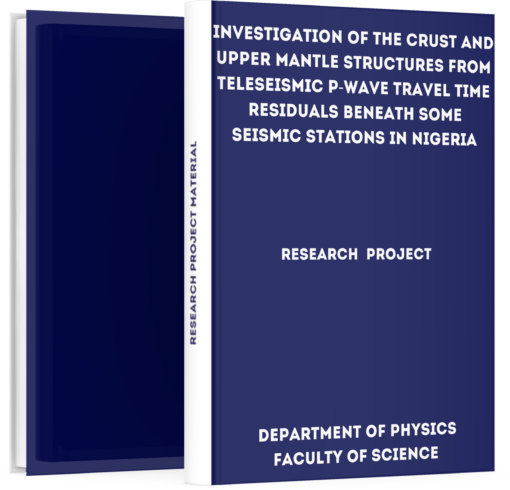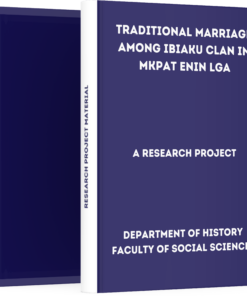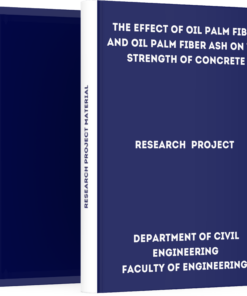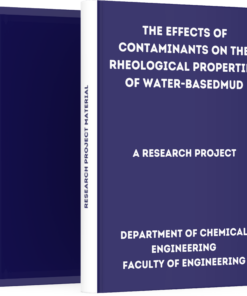Investigation of the Crust and Upper Mantle Structures from Teleseismic P-Wave Travel Time Residuals Beneath some Seismic Stations in Nigeria
₦3,000.00
If you are interested in getting this project material “Investigation of the Crust and Upper Mantle Structures from Teleseismic P-Wave Travel Time Residuals Beneath some Seismic Stations in Nigeria”, click on the DOWNLOAD BUTTON to make payment and the file will be delivered to your email immediately after confirmation.
Description
– Investigation of the Crust and Upper Mantle Structures from Teleseismic P-Wave Travel Time Residuals Beneath some Seismic Stations in Nigeria –
Download Investigation of the Crust and Upper Mantle Structures from Teleseismic P-Wave Travel Time Residuals Beneath some Seismic Stations in Nigeria. Students who are writing their projects can get this material to aid their research work.
Abstract
The crust and upper mantle structure beneath some seismic stations in Nigeria from the study of teleseismic P-wave travel time residuals has been investigated with the aim of determining the velocity structure within the crust and the upper mantle.
This was achieved by using Seismic data from three stations at Ile-Ife, Nsukka and Kaduna which were consistent with data from July 2009 to July 2011. Five hundred and sixty-six (566) events were recorded: Ile-Ife, 109 events, Nsukka, 240 events and Kaduna, 217 events.
The travel time plot for each of the three stations shows correlation with the standard travel time plot. The travel time residuals calculated with respect to the International Association for Seismological Practices 91(IASP91) model for each of the stations ranges from -0.52 s to 4.93 s with an average value of 1.8 ± 1.3 s for Ile-Ife station,
-1.15 s to 4.4 s, with an average of 1.9 ± 1.4 s for Nsukka station and from -0.35 s to 4.86 s with an average 2.2 ± 1.3 s for Kaduna station. The large standard deviation in the average residuals is accounted for by considering the heterogeneity in the travel paths of the seismic waves to the recording stations.
Therefore, to ensure that the data belong to a fairly homogeneous path, the events were divided into three azimuthal regions where the events are more concentrated and new residuals for each region were calculated for each station:
For Ile-Ife station Region I (30o-90o) has average new residuals of 1.8 ± 0.3 s, Region II (210o-270o), 1.8 ± 0.3 s and Region III (270o-330o) 1.5 ± 0.4 s; For Nsukka station, Region I has new average residuals of 1.83 ± 0.9 s; Region II, 1.90 ± 0.5 s and Region III 1.5 ± 0.7 s while for Kaduna station,
we have Region I, 2.2 ± 0.6 s; Region II, 2.2 ± 0.5 s and Region III, 1.7 ± 0.6 s. The new station residuals show less scatter hence the standard deviations are lower because the data sets now belong to fairly homogeneous travel paths.
Introduction
1.1 Background of the Study
An earthquake is the result of sudden release of energy in the earth’s crust that creates seismic wave. Everyday about fifty or more of such events occur worldwide, with the magnitudes which are strong enough to be recorded in Nigeria.
Each earthquake event radiates seismic waves which travel throughout the earth, some of these waves are readily detected with modern instrument (seismometer) stationed anywhere on the globe.
Depending on the distance of the earthquake focus from the recording station, the recorded seismic events are classified as local, regional or teleseismic event (Lay and Wallace, 1995).
The branch of science which deals with the study of generation, propagation and recording of elastic waves through the earth and of the sources that produce them is known as seismology. Seismological procedures provide the highest resolution of internal earth structure of any geophysical method.
This is because elastic waves have the shortest wavelength of any geophysical wave and the physics that governs them localizes their sensitivity spatially and temporarily to the precise path travelled by the energy (Lay and Wallace, 1995).
How to Download this Project Material
First, note that we are one of the best and most reliable online platforms because we don’t retain any of your personal information or data as regards making payments online.
PRICE: ₦3,500 ₦3,000 (Three Thousand Naira Only)
Make a bank deposit or mobile transfer of ₦2,000 only to the account given below;
Bank Name: UBA Account Number: 1022564031 Account Name: TMLT PRO SERVICES
After making the payment, CLICK HERE to send the following on WhatsApp;
- Depositor’s Name or Screenshot of Payment
- Name of the Past Question
- Active Email Address
or Call Us On +2348082284439 Once your details have been received and your payment confirmed by us, you will receive the past question in your email or WhatsApp within 5 Minutes.
Guarantee of Getting the Material
We understand that due to the high rate of fraud, many people are afraid of making purchases online but be rest assured that PastExamQuestions will deliver your material after payment.
Once your details have been received and your payment confirmed by us, you will receive the past question in your email or WhatsApp.
Give us Feedback
Have we been able to satisfy you? How well do you think the material will be helpful after having gone through it? Does the price worth the material?
Let’s hear from you! We recommend that our customers give feedback at the end of every transaction to enable us to serve better. You can do this by clicking the review button on this page.
Where is the review button? >> Just scroll up to where you see reviews





Reviews
There are no reviews yet.